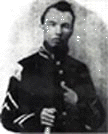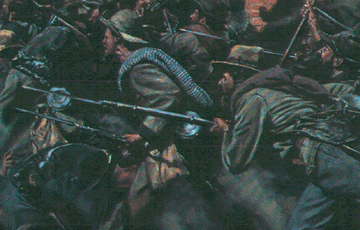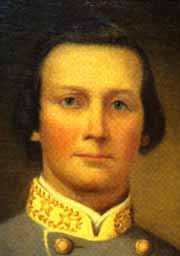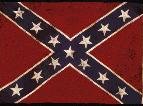|
South Carolina C.S.A.
|

|
South Carolina at the Battle of Franklin
|

|
South Carolina C.S.A. |
|
Company A |
 |
When the men of the Army of Tennessee topped Winstead Hill at the end of November in 1864 they saw the beautiful rolling land of middle Tennessee extending toward the Harpeth River on the right and the pike to Spring Hill on the left. These features would act as a funnel crowding the Confederates ever closer together as they moved toward the Union line. Union soldiers were in the field a long distance away and still further away lay the breastworks and the village of Franklin. W.D. Batson felt the view was beautiful and the sights a bit scary. |
|
In Stewart's Corps, the Divisional alignment from left to right was French, Walthall, and Lorning. The Brigade alignment in Stewart's Corp from left to right was Cockrell followed by Sears, then Reynolds, then Quarales followed by Shelley, then Featherston followed by Scott and finally on the far left of the Confederate line was Adams. Stephen D. Lee was still coming up and the artillery had not arrived when Hood committed to the assault. The men advanced until they met a line of resistance thrown out in front of the works. Most students of the battle believe this gave the Confederates a distinct advantage. These men scrambled back toward the safety of the fixed fortifications that had been put up during the earlier battle at Franklin. The Union forces occupying those breastworks hesitated to shoot their comrades. I suspect this assessment is correct but it also had the effect of imposing fire discipline on the Union soldiers that they might not normally have had. It allowed the Confederates to strike sharply, but they were exhausted from the march. It also allowed the Union to unleash a tremendous concentrated fire on them as the last of those posted outside the line scrambled to safety. Around the Carter House and the Carter Gin, the assault was terrible. The Union line was broken and in one of those flukes of war, a Union Colonel who had disobeyed his orders found himself in the right place at the right time with the right instrument. Much would happen to Colonel Emerson Opdycke because of his actions that day but the one thing that would not happen was his dismissal. He would be remembered by many on both sides for his actions in the backyard of the Carter House on that late afternoon in November. As nightfall came and Lee's Corps arrived on the scene, it too was committed to a grisly night attack that would grind Hood's hopes and his army to powder. As the fighting died out in the late evening, Schofield prepared to escape toward Nashville and John Bell Hood in his delusion felt he had gained a victory. The mornings light would bring a far different assessment to those who were to proceed toward Nashville without the help of laudanum and delusion. |
Brown's Division held the line captured from Strickland's brigade of Ruger's division at the locust abatis, and the struggle for the recovery of the works was most bloody and prolonged. Gist's and Gordon's brigades with undaunted courage held the works they captured. Gist was killed, Gordon captured, and Brown with heroic resolution threw into the vortex of battle his reserve, composed of Strahl's and Carter's brigades. Fierce, bloody and continuous was the fight. Brown continued to hold the works, when the assaulting forces on his right were repulsed with appalling loss. His right, although n possession of the captured line, was subjected to a crossfire from the angle in the entrenched line immediately west of the gin-house. Bate's line was not connected on his left, and his left flank was threatened, and likewise subjected to crossfire. Brown maintained his lodgment in the works, with both flanks uncovered, exposed to a cross fire, with obstinate endurance.
Southern Bivouac, Vol. IV, page 11 Immediately after dark General Hood ordered Johnson's division of Lee's corps, which arrived during the action, to assault the works to the left of the Columbia pike. This fine division, without support, in dense darkness, moved gallantly over the field thickly strewn with the dead and wounded, and charged the works held by Ruger's division. The storm of battle was again renewed. Kimball and Ruger delivered a deadly fire into Johnson and Managault fell severely wounded, and his brigade with Sharpe's, Brantley's and Deas' brigades, suffered heavily, and were repulsed. After this ragged firing continued with occasional volleys until after 10 o'clock. Southern Bivouac, Vol. IV, page 13 |
|
|
|
Groom, Winston; Shrouds of Glory; ISBN# 0-87113-591-4;1995. Sword, Wiley; Embrace an Angry Wind, The Confederacy's Last Hurrah: Spring Hill, Franklin, and Nashville; ISBN#0-06-016301-1; 1992. Monographs: Crownover, Sims; The Battle of Franklin; Tennessee Historical Quarterly, Volume XIV, Number 4, November, 1955. Available through The Carter House Association, Franklin, Tennessee. Taylor, John Stuart; Sixteenth South Carolina Regiment, C.S.A.; Greenville,S.C., 1964. NOTE: Taylors work is long out of print and rarely available. The Battles for Franklin and Nashville; A collection of articles from Civil War Illustrated; Published by Eastern Acorn Press, 1988. United Daughters of the Confederacy, Franklin Chapter Number Fourteen; McGavock Confederate Cemetery; Franklin, Tennessee; 1989. Other Suggested Reading: Connelly, Thomas; Autumn of Glory Dyer, Richard; The Gallant Hood Horne, T.B. Van; The Decisive Battle of Nashville and the Army of Tennessee Watkins, Sam; Company Atcyh |

|
|

|